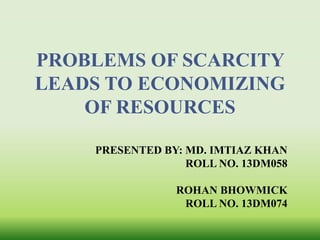PROBLEMS OF SCARCITY LEADS TO ECONOMIZING OF RESOURCES
•Als PPTX, PDF herunterladen•
3 gefällt mir•9,617 views
Melden
Teilen
Melden
Teilen

Empfohlen
Empfohlen
Weitere ähnliche Inhalte
Was ist angesagt?
Was ist angesagt? (20)
Supply and Demand, Law of Demand,Law of Supply, Equilibrium

Supply and Demand, Law of Demand,Law of Supply, Equilibrium
Andere mochten auch
Andere mochten auch (19)
Measuring and mitigating natural resource scarcity

Measuring and mitigating natural resource scarcity
Market research mb mk 02 - MBA - III Sem, UPTU Syllabus

Market research mb mk 02 - MBA - III Sem, UPTU Syllabus
Ähnlich wie PROBLEMS OF SCARCITY LEADS TO ECONOMIZING OF RESOURCES
Ähnlich wie PROBLEMS OF SCARCITY LEADS TO ECONOMIZING OF RESOURCES (20)
Lecture1 Economic problem, Economic Agents, Types of economic analysis

Lecture1 Economic problem, Economic Agents, Types of economic analysis
Mehr von md imtiaz khan
Mehr von md imtiaz khan (6)
PROBLEMS OF SCARCITY LEADS TO ECONOMIZING OF RESOURCES
- 1. PROBLEMS OF SCARCITY LEADS TO ECONOMIZING OF RESOURCES PRESENTED BY: MD. IMTIAZ KHAN ROLL NO. 13DM058 ROHAN BHOWMICK ROLL NO. 13DM074
- 2. INTRODUCTION • Unlimited wants: First fundamental fact – Human wants are unlimited & they want to use the goods and services to the fullest which will satisfy their needs. • Scarce resources: Second fundamental fact – Economic resources are limited relative to wants. – Producers face the problem of what to produce, how to produce & for whom to produce.
- 3. SCARCITY • It is the fundamental economic problem of having unlimited human wants which is required to be fulfilled in a limited resources. • It states that society has limited productive resources to fulfill all human wants & needs. • In other words, scarcity implies that all the goals of society cannot be pursued at the same.
- 4. SCARCITY: ECONOMIC PROBLEM • According to Lionel Robbins, “Economics is the science which studies human behavior as a relationship between ends and scarce means which have alternative uses.” • The problem of scarcity is that our wants are always beyond what we can produce with our resources. • Economics is the solution to this problem of what resources to use, How best to use them, and when to use them.
- 5. SCARCE RESOURCES • Our resources are limited by the 4 factors of production : • Land • Labour • Capital • Enterprise. • Resources: all natural, human, & other resources used in the production of goods & services. • Property (Land, Raw Materials & Capital) • Human (Labour & Entrepreneurial)
- 6. ECONOMIZING OF RESOURCES • Economizing of resources means using of resources in best possible way and to their fullest capacity. • The fundamental issue that arises is scarcity of goods and services compared to the demand for them by consumers. • Solving the economizing problem for a business involves making decisions about best allocation of resources to produce the maximum out of it.
- 7. EMPLOYMENT AND EFFICIENCY • Economics is a science of efficiency in the use of scarce resources. Efficiency requires full employment of available resources and full production. • Full employment means all available resources should be employed. • Full production means that employed resources are providing maximum satisfaction of our economic wants. • Example:
- 8. UNEMPLOYMENT & INEFFICIENCY • The economy would produce less as there would be less input of human resources & the resources would not be utilized to the maximum. • This would also decrease the performance of the existing employees due to lack of competition. • A move toward full employment & efficiency would yield a greater output of one or both products. • Example:
- 9. CONCLUSION • As human wants are unlimited and resources are scarce, economizing of resources is very important. • Some effective solutions are: - Optimum utilization of resources - Full employment - Full production - Adoption of advance technology
- 10. THANK YOU